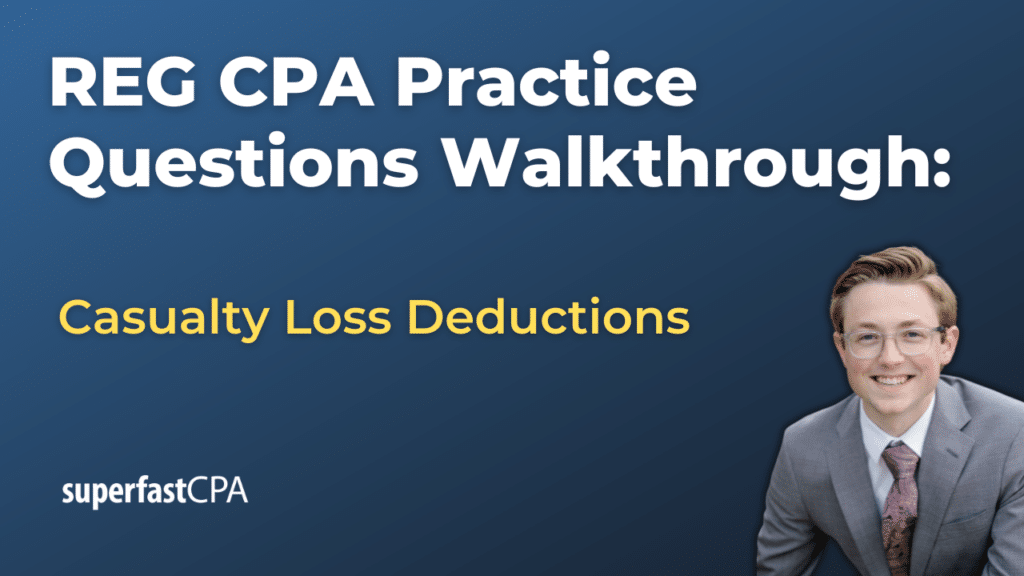In this video, we walk through 5 REG practice questions demonstrating how to calculate casualty loss deductions on an individual’s tax return. These questions are from REG content area 4 on the AICPA CPA exam blueprints: Federal Taxation of Individuals.
The best way to use this video is to pause each time we get to a new question in the video, and then make your own attempt at the question before watching us go through it.
Also be sure to watch one of our free webinars on the 6 “key ingredients” to an extremely effective & efficient CPA study process here…
How to Calculate Casualty Loss Deductions
Under recent tax law revisions, individual taxpayers can only deduct casualty losses if these losses occurred in a federally declared disaster area.
1. Determine Eligibility for Federally Declared Disaster Areas
- Federally Declared Disaster: The first criterion is that your casualty loss must have occurred in an area that was declared a federal disaster area by the President. This includes events like hurricanes, floods, earthquakes, wild fires, and similar natural disasters.
2. Calculate the Loss Amount
- Cost Basis or Fair Market Value: Determine the lower of the property’s cost basis or the decrease in fair market value due to the casualty or theft.
- Cost Basis: Usually the amount you paid for the property, plus any improvements.
- Fair Market Value: The decrease in value of the property as a direct result of the disaster.
- Insurance Reimbursements: Subtract any insurance or other compensations you received. Only unreimbursed losses after recoveries are deductible.
3. Apply Deduction Limits for Federally Declared Disasters
- $100 Rule: Subtract $100 from the total loss amount for each casualty event.
- 10% AGI Rule: Reduce the total of your casualty losses (minus any required $100 per-event reduction) by 10% of your Adjusted Gross Income (AGI). Only the amount exceeding this calculation is deductible.
4. Claiming the Deduction on Your Tax Return
- Form 4684 Usage: Utilize IRS Form 4684 (Casualties and Thefts) to compute the allowable loss deduction.
- Incorporate into Schedule A: The deduction amount calculated on Form 4684 should be reported on Schedule A (Itemized Deductions) and attached to the IRS Form 1040.
Example:
James experiences a severe flood in his home due to a hurricane, which occurred in a federally declared disaster area. The flood caused significant damage to James’s home and personal property.
- Pre-disaster value of home and property: $300,000
- Post-disaster value of home and property: $220,000
- Cost Basis of the home and property: $250,000
- Homeowner’s Insurance Reimbursement: $20,000
- James’s Adjusted Gross Income (AGI) for the year: $100,000
Steps to Calculate Deduction:
- Determine Loss Amount:
- Decrease in Fair Market Value (FMV) due to the disaster is $300,000 – $220,000 = $80,000.
- Since the cost basis ($250,000) is higher than the decrease in FMV, we use the decrease in FMV for calculating the loss.
- Subtract Insurance Reimbursement:
- $80,000 (loss amount) – $20,000 (insurance reimbursement) = $60,000 (unreimbursed loss).
- Apply Deduction Limits:
- $100 Rule: $60,000 (unreimbursed loss) – $100 = $59,900.
- 10% AGI Rule: 10% of James’s AGI is 10% of $100,000 = $10,000.
- $59,900 – $10,000 = $49,900 (amount eligible for deduction).
Result:
James can claim a casualty loss deduction of $49,900 on his tax return, assuming he itemizes his deductions and meets all other requirements.
Documentation and Record Keeping:
- James should keep records of the pre-disaster and post-disaster valuations of his property, any appraisals conducted, the cost basis of his property, details of the insurance claim and reimbursement, and his calculations for the loss deduction. These documents are crucial for substantiating the claim on his tax return.
Claiming the Deduction:
- James needs to fill out IRS Form 4684 (Casualties and Thefts) with the calculated loss and include this information on Schedule A (Itemized Deductions) of his Form 1040 tax return.













